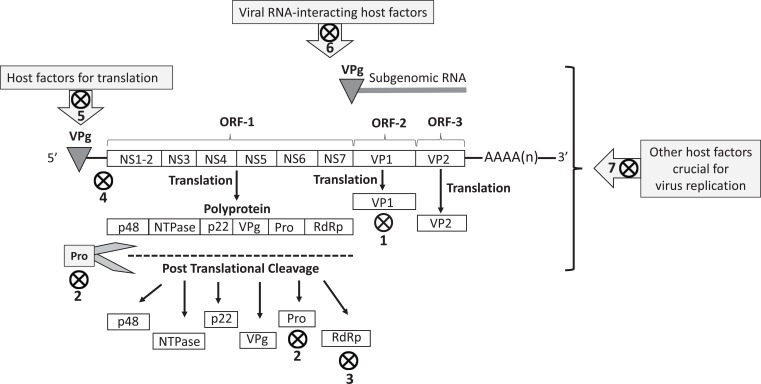Fig. (1).
The norovirus genomic RNA, subgenomic RNA, and structural (VP1 and VP2) and nonstructural (p48, NTPase, p22, VPg, 3CLpro and RdRp] viral proteins. The VPg protein covalently binds to the 5’- end of the viral genomic and subgenomic RNA, whilst the 3’- end of the viral RNA is polyadenylated. Anti-noroviral targets, including potential targets, have been shown with symbol. 1. Virus capsid (VP1)-host cell receptor binding blockers: carbohydrate analogs of fucose (citrates, glucomimetics), heparan sulfate analogs (Suramin), soluble histones, tannic acid, and HBGA-blocking monoclonal antibodies. 2. 3C-like cysteine protease (3CLpro) inhibitors: peptidyl transition state (TS) inhibitors, latent peptidyl TS inhibitors, peptidyl TS mimics, Macrocyclic peptide inhibitors, and Rupintrivir. 3. RNA-dependent RNA-polymerase inhibitors: nucleoside (Ribavirin, Favipiravir and 2'-C-methyl-cytidine) and non-nucleoside (Suramin and NF023) analogs. 4. Targeting viral RNA: Peptide-conjugated phosphorodiamidate morpholine oligomers (PMO), and siRNA. 5. Targeting VPg-host factors interactions: Hippuristanol. 6. Targeting viral RNA-interacting host factors: potential inhibitors of factors, such as La, PTB, DDX3, PCPB2, and hnRNPs. 7. Targeting other host factors/pathways crucial to virus replication, such as inhibitors of cellular deubiquitinases (WP1130 and 2-Cyano-3-Acrylamide Compound-6), molecular chaperone hsp90, and cholesterol pathways.

